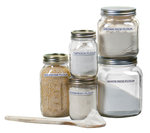

I found out in January of 2018 that I had celiac disease.
The diagnosis came after being sick for three years while doctors couldn’t figure out why. I took countless tests that kept coming back normal, until they finally tested me for celiac disease with a blood test.
My tissue transglutaminase antibodies (tTG) numbers came back very high, and so began my gluten-free journey.
Knowing nothing about celiac disease or gluten for that matter, I turned to books and the internet for research. I learned that gluten (wheat, rye, barley and malt) is in what seemed like just about everything. Also, the longer I stayed away from gluten, the sicker I got when I accidentally ingested some.
I had times where it would flare up so bad that I could hardly walk.
Here is what I, as a person with celiac disease, want you to know.
No, we can’t have just a small amount of gluten. Even cross contamination can make us really sick.
No, there is no magic pill we can take where we can now eat gluten, even though I really wish there was.
Yes, celiac is a real disease. It is a serious autoimmune disease that occurs in genetically predisposed people where the ingestion of gluten leads to damage in the small intestine. When people with celiac disease eat gluten, their bodies trigger an immune response in their small intestines. Over time, this reaction damages your small intestine’s lining and prevents it from absorbing some nutrients (malabsorption). The intestinal damage often causes diarrhea, fatigue, weight loss, bloating and anemia, and it can lead to more serious complications.
About 1 percent of the population has celiac disease. The true percentage is probably much higher, but you can have it and have no symptoms.
I had my children tested for celiac disease, and also completed the celiac genetic test. People with celiac disease carry one or both of the HLA DQ2 and DQ8 genes, but so does up to 25-30 percent of the general population. Carrying HLA DQ2 or DQ8 is not a diagnosis of celiac disease, nor does it mean you will ever develop celiac disease. However, if you carry HLA DQ2 and/or DQ8, your risk of developing celiac disease is 3 percent instead of the general population’s risk of 1 percent.
Celiac disease is genetic, meaning it runs in families. First-degree family members (parents, siblings and children) who have the same genotype as the family member with celiac disease have up to a 40 percent risk of developing celiac disease.
My son ended up having it and had zero symptoms. That is what is so scary. You can be unaware you have it and be doing horrible damage to your body. The earlier it’s detected, the better chance your small intestine has of recovery. We are now a 100 percent gluten-free household after my son’s diagnosis.
The first three months going gluten-free were the hardest. It’s a complete lifestyle change. I had days where I would sit in my car on my lunch breaks and cry because I couldn’t find anywhere safe to eat. I remember my first time eating out after going gluten-free. I was in Seattle and my family wanted to eat at the Hard Rock Cafe, and it was a nightmare. I had to ask 500 questions, and it can feel quite embarrassing. I always feel like they think I am a high maintenance snob (I still haven’t gotten over this). Over time, you learn where you can eat, what questions to ask, and how to be prepared ahead of time. The Find Me Gluten-Free cellphone app is a lifesaver. It shows you restaurants in the area and rates them on their safety. It also has reviews from people who have eaten there. I also use this app a lot when I travel in order to plan ahead.
When you have celiac disease, planning ahead is very important. You can’t just impulsively stop for food somewhere. I drove to Las Vegas last summer and planned out all my stops for meals for my 18-hour drive there and back. I had planned where I would stop for breakfast, lunch and dinner each day, and that gave me so much more peace of mind.
Over time, I have learned that a lot of my old favorite recipes can be made gluten-free with minor changes. I’ve also learned the best places to eat in Clark County. Portland has a lot more options, but I am not there often, so I had to find where I could eat in my neighborhood.
If you have celiac disease, or are going gluten-free for other reasons, here are some of my favorite places to go:
• Chipotle is great. You can order a bowl and tell them you have celiac disease and they will wipe everything down and get items from the back. Try not to go during lunch rush, because you will slow down the line.
• Rising Sun in Battle Ground has allowed me to eat Asian food again (my favorite). They make everything fresh to order and have gluten-free soy and teriyaki sauces. My favorite menu item is their shrimp fried rice.
• Planet Thai in Salmon Creek is my favorite Thai place. Just make sure you order your Thai food gluten-free.
• Frontier Public House is a great option if you want a more sit down meal. They have lots of gluten-free options.
• Vancouver Pizza Company is my favorite gluten-free pizza. They have a separate, dedicated space where it is made.
• Corbett Fish House in east Vancouver is the only 100 percent dedicated gluten-free restaurant that I know of in the area (I hope there will be more to follow). They have great fish and chips and onion rings.
Getting this diagnosis can make us feel helpless in the beginning. Trust me, I know; my favorite food was cake. But I am here to tell you that you are not alone, and over time you will learn to adapt like I did. Hopefully my restaurant tips and recipes serve as a good guide to start.